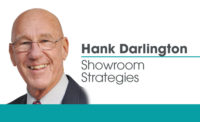Strategic adjustments can make your showroom more profitable
The 2% windfall.


|
I just finished reading the synopsis of a book entitled “The 1% Windfall” by Rafi Mohammed.
I strongly recommend you read it. It reminded me once again that the average gross margin on sales for plumbing wholesaler showrooms is lower than it should be. Yes, this is my opinion. However, after so many years of working with many of you and seeing the results of several Supply House Times surveys that we’ve done, I know for a fact the average showroom margin of +/- 30% is just too low.
When you consider the cost of building out a well-done showroom and then plugging in the cost of operating it, the return on investment in the showroom business just isn’t as good as it should be.
Let’s take the numbers a step further. Here’s an example of what I would consider to be an “average” showroom’s consolidated profit-and-loss statement:
| Annual Sales | $3,000,000 |
| Average annual GP% | 30% |
| Average annual GP$ | $900,000 |
| Average annual operating expenses | $810,000 |
| Average annual net profit dollars | $90,000 |
| Average annual net profit % | 3% |
And yes, I’m aware of the various volume rebates that are “earned” via buying groups, vendor agreements, etc. Some wholesalers may add these plus-dollars into the mix and some do not. Regardless, I don’t believe that a 3% net profit is all that good. Heck, our financial advisor helps me earn more than twice this much and I don’t have the worry and headaches of running a business.
I have written several articles over the years on how to grow your gross profit margins. I have had wonderful success in working with dozens of you in helping you grow your profitability. In most cases these increases are more than 5% in gross profit margin.
Having worked the first part of my career in managing a couple fairly large plumbing wholesale businesses, I understand the challenge you have. The manufacturer dictates what you pay for the product and the tradespeople dictate what they’ll pay for it. Historically, this hasn’t left much in between that you can chalk up as profit. Thank goodness for the buying groups! Thus, I do understand the wholesale mentality that naturally flows over into the showroom side of the business. I understand it, but I don’t agree with it.
The showroom operation is an entirely different business model. It’s a lot more retail than it is wholesale. This is especially true with the consumer (homeowners) becoming the No. 1 customer in your showrooms. The plumber no longer is dictating what your sell price must be. At least I hope that’s true! Before you say it, I am fully aware of the Internet and the role it plays in your pricing policies.
The key to growing your profitability on sales in your showrooms is creativity. You must be willing to change how you’ve established pricing guidelines in the past. I have a number of thoughts on how you can do this.
First, let me start with a few “nuggets” from Mr. Mohammed’s book:
Stop marking up costs: The most common mistake in pricing involves setting prices by marking up costs. Telling yourself you need a 30% margin is not good. While it’s easy to implement, these “cost-plus” prices bear no relation to the amount consumers are willing to pay. As a result, profits are left on the table.
Set prices that capture value: The first thing you have to do is identify what your various value points are (for the individual sales consultants and the company). You have to start “thinking like a customer!” Customers evaluate the products and services, make comparisons and then ask themselves, “Are the extra bells and whistles worth the price premium (organic vs. regular) or does the discounted, stripped down model make sense (private label vs. brand name)?” They will choose the product that provides the best deal (prices vs. attributes).
Create a value statement: I’ve also “preached” on this subject several times! Every company should have a value statement that clearly articulates why customers should purchase your product over a competitor’s offerings. Be specific in listing these reasons. Brag! This is not a time to be modest. The value-added bullet points (about the sales consultants and the company) will boost the confidence of your frontline so it can look customers squarely in the eye and say, “I know you have options, but here are the reasons why you should buy our product.”
Higher profits: Reinforce to your sales team that it is OK (even desirable) to earn higher profits. I’ve found that too many showroom sales consultants are uncomfortable setting prices above what they consider to be “fair” and are quick to offer unnecessary discounts. It is fair to charge “what the market will bear” prices to compensate for the hard work and financial risks necessary to bring products to market. It also is important to reinforce the truism that most customers are not loyal. If they can find a better value or price, many will defect. Check the parking lot at your local “big box” and see how many of your “loyal” trades customers are stopping in there because “it’s more convenient.”
Offer product versions: One of the easiest ways to enhance profits and better serve customers is to offer good, better and best versions. These options allow customers to choose how much to pay for a product. Most of you do it. But are you displaying the products this way? For example, do you have the lower-priced faucets all together with the mid-priced and higher-priced ones also grouped together?
Implement differential pricing: For any product, some customers are willing to pay more than others. Yes, you are a wholesaler, but you look like a retailer. This is another good reason to have a different name for your showroom business. Most homeowners coming into your showroom don’t expect to receive wholesale prices. Nordstrom and Tiffany’s don’t negotiate or cut their prices. What the tag says is what you pay. I suggest that charging list price for products, especially if it’s only one or a few items is not only OK, but preferable. If you’re quoting a large order then you can pull out the wholesale “card” and extend some modest discounts.
More margin-growing tips
The following are some more “Darlington Tips” on how to grow your margins.
Don’t give a “list price” with a discount. Ever! Quote only net prices. Your net prices!
Don’t give out the model number. Ever! Quote only your own internal company product code.
If you have to extend discounts, mix them up. Who says you have to do 35% across the board? Mix it up! Maybe you will have to do a deeper discount on the popular, well-shopped items, but you don’t have to on other items. Here’s an example: You have to be competitive on a very popular kitchen sink, but you can make more on the faucet and even more on all the accessories that go with the sink (strainer, cutting board, soap dispenser, hot/cold dispenser, colander, etc.).
Don’t extend warehouse discounts to tradespeople buying through the
showroom. The showroom adds a lot more value to the sale. Therefore you have to make more.
Since pricing is an underutilized strategy, it’s fertile ground for new profits. The beauty of focusing on pricing is that many concepts are straightforward to implement and can start producing profits almost immediately.
The title of this article is “The 2% Windfall” (1% more than the title of Mr. Mohammed’s book). Here’s what my 2% growth to gross profit margin does to the P & L example I showed in the beginning of the article:
| Annual Sales | $3,000,000 |
| Average annual GP% | 32% |
| Average annual GP$ | $960,000 |
| Average annual operating expenses | $810,000 |
| Average annual net profit dollars | $150,000 |
| Average annual net profit % | 5% |
That little ole’ 2% windfall (the improvement in GP margin) equates to a 66.7% improvement in net profit dollars. All of a sudden you owners and managers will like the showroom business a whole lot more!
That’s only the beginning because you really should be enjoying margins in the 35% and more range. If you would like more tips on how to grow your GP margins give me a call or send me an email.
Have fun and good selling.
HELPFUL LINKS:
Looking for a reprint of this article?
From high-res PDFs to custom plaques, order your copy today!





